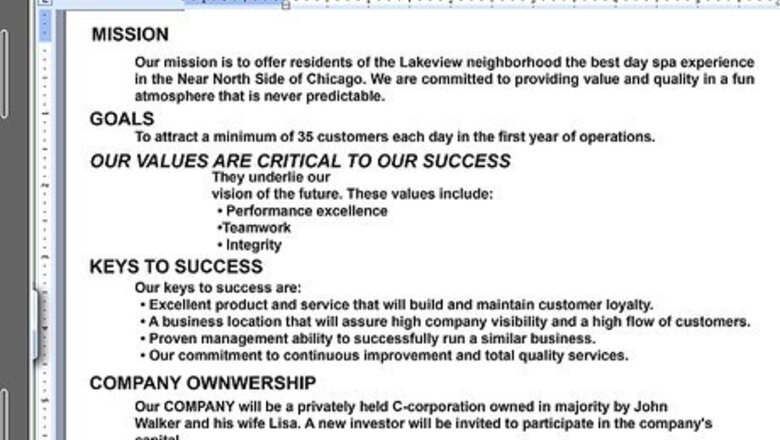
views
Explaining Your Marketing Plan
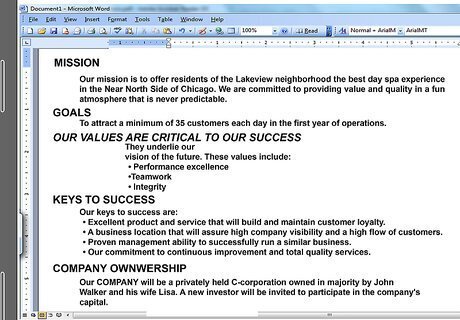
Describe your mission and objectives. Under the heading “Company Description” you should describe your company in more detail. This section fleshes out some of the information provided in the executive summary. For example, you can mention the following: Your mission. What is your driving goal every day? Don’t simply write, “Make money.” Identify how you will make money. For example, you can write: “Our mission is to offer residents of the Lakeview neighborhood the best day spa experience in the Near North Side of Chicago. We are committed to providing value and quality in a fun atmosphere that is never predictable.” Your goals. For example, a day spay might have the following goal: “To attract a minimum of 35 customers each day in the first year of operations.” Make your goals as concrete as possible. Description of the industry. Explain whether the industry is growing or poised for growth in the short and long term. The factors that will drive your success. How will you set yourself apart? For example, “You All Day will separate itself from the pack based on the owner’s deep experience running a day spa in Seattle for ten years. This experience includes familiarity with successful marketing techniques and trends analysis.” Your legal form. Are you a sole proprietorship, partnership, limited liability company (LLC), or corporation? Also explain why you selected this form. EXPERT TIP Jack Herrick Jack Herrick Founder of wikiHow Jack Herrick is an American entrepreneur and wiki enthusiast. His entrepreneurial projects include wikiHow, eHow, Luminescent Technologies, and BigTray. In January 2005, Herrick started wikiHow with the goal of creating "the how-to guide for everything." He has a Master of Business Administration (MBA) from Dartmouth College. Jack Herrick Jack Herrick Founder of wikiHow Don’t skimp on how much energy and time you put into your mission. When asked about creating wikiHow’s mission, Jack Herrick, founder of wikiHow, responded: “We had the whole management team — alongside members of the wikiHow community — reviewing it, discussing it, and going back and forth on the wording. Those two sentences were many hours of work.”

Discuss your industry. Include a section under the heading “Industry Analysis” and talk about your industry at a high level. For example, discuss whether the total industry is growing and how quickly. Also talk about trends in consumer preferences. You’ll need to do research, so go to the library and ask your librarian for help finding information about the industry. You can search for industry information in other places. For example, talk to people in your industry at trade shows. Also search online. Many industries have trade associations, which have websites with information. For example, when analyzing the day spa industry, you might want to talk about how it is growing because more upper-income men in urban areas are visiting. (If that’s true). By analyzing the industry, you gain insight as to your likely target market and how you can reach them.
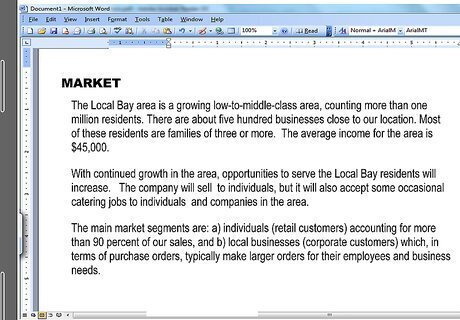
Identify your target market. Although it might be nice to think the entire world is your market, businesses usually service a niche. You need to identify that niche. For example, think about the following characteristics of your target market: Age. What is the average age of your likely customer? If you don’t know, then visit similar businesses and note the ages of the clientele. Gender. Will men or women—or both—primarily use your products or services? Location. Generally, your market will be located near your business. However, if you have a web-based business, your target audience could have no geographic boundaries. Income level. Occupation. For example, a day spa might target stressed-out white collar professionals. Education level. There is often a link between education, income, and occupation—though not always. For example, a discount bookstore might target an educated audience that nevertheless has a lower income.

Scope out your competition. Who will you be competing with? Identify your competitors. For most businesses, your competitors will be located nearby. However, if you have an Internet-based business, your competitors could be any business offering similar products or services. To find competitors, look in the phone book and do a general Google search. Make sure to read their website and stop into the business. If you’re opening a restaurant, you’ll want to see a sample menu, as well as the hours of operation. Also identify indirect competitors. For example, a day spa is competing with more than other spas. You also compete with any business that offers relaxation, such as massage parlors or meditation centers.
Draft a competitive analysis. Once you’ve studied your competition, explain in your business plan how you will stack up. You can create a chart, which should contain the following: Name of your competitor. What you offer that they don’t. Think about products and services, but also location, ease of ordering, etc. What will make the consumer experience different at your business? What they offer that you don’t. Identify why you don’t offer their products or services. For example, they may be serving multiple niches while you are focused on only one. Alternately, they may have a favorable location.
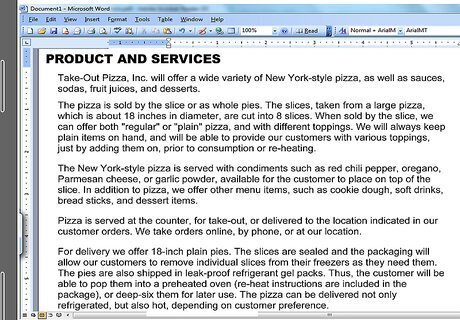
Describe your products and services. Go into detail about what products or services you will offer and how you will offer them. For example, if you are starting a pizza shop, then you will want to include the following: Whether you will sell pizza by the slice, as whole pies, or both How big your pizzas will be What toppings your customers can offer If you will have take-out and delivery options What other food items will be sold
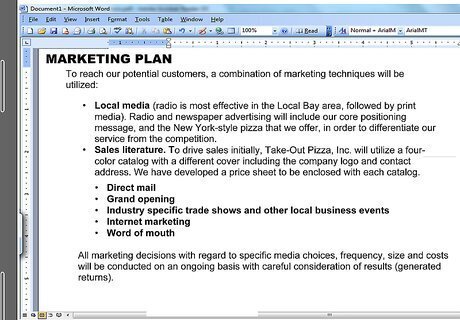
Devise your marketing plan. After identifying your market, you should explain how you will reach it. Consider the following and include it in your business plan under the marketing section: What type of advertising or promotion will you use? How often will you use paid promotion? What other promotion other than paid advertising will you use? For example, you might use social media, professional networks, etc. Will you create a logo and use it on cards, letterhead, websites, etc.? How large will your promotional budget be?
Discussing Your Business Organization
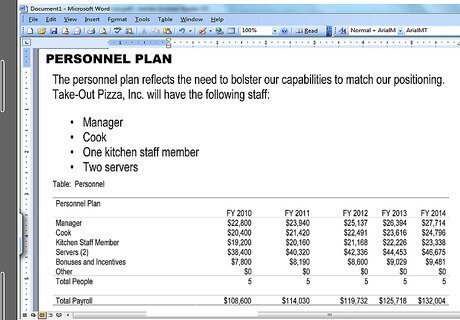
Explain your daily operations. Give your reader some idea of how many people will be working for the startup. You should identify their positions. If you have 10 or more employees, then create an organizational chart. This chart should identify the hierarchy in the business. State how much you expect to pay each employee in your first three years of business. Also name your professional support, such as your business lawyer, accountant, and insurance agent. Professionals are independent contractors you use but don’t employ. Calculate how much you expect to spend on each professional.
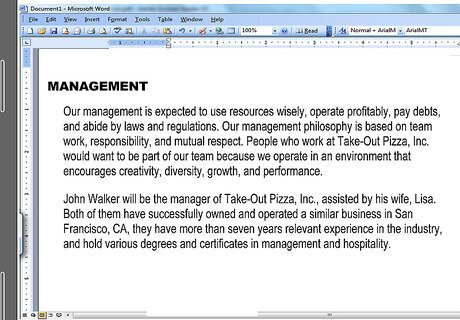
Identify management. If you’re running a sole proprietorship, this is easy. However, larger startups will need to identify who will run the business and provide a little information about their backgrounds. For example, you should identify the daily manager, support staff, etc. You might write: “Lisa Jones is the sole proprietor of You All Day and will run day-to-day operations. As a certified massage therapist, she ran the Relax! chain of day spas in the Greater Seattle area for ten years. A former accountant, Lisa has an MS in accounting from the University of New Hampshire and worked as a CPA briefly before going into the spa business.” If you are asking for a loan, then include resumes for each owner. You can put them in the appendix at the end of the document.
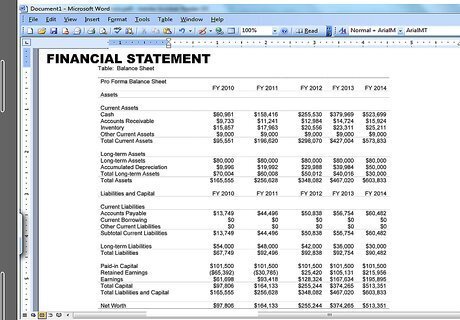
Provide personal financial statements. As a startup, banks will look at your personal credit history and financial situation when deciding whether to make a loan. Accordingly, you’ll need to include information for each business owner. You should create professional-looking financial statements using a spreadsheet. You’ll have to gather quite a bit of information to make the financial statement. For example, you will need information on your assets, investments, and personal debts. You might also want to get a free copy of your credit report and review it as you draft your business plan.
Analyzing Business Finances
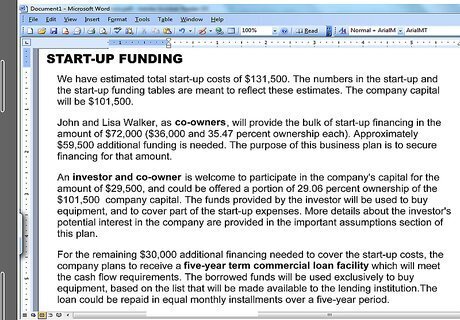
Explain your start-up costs. You’ll need to research how much it costs to start your business. If you’ve created a similar business before, then you can rely on that information. If not, you should talk to other business owners. Be conservative when estimating startup costs. Generally, everything will cost more than you expect. Common startup costs include insurance, licenses, equipment, advertising, and employee expenses. Also identify the source of the startup capital. For example, if your startup has three initial owners, state how much each is contributing to the business and their ownership percentage. If you need financing, state how much. Include the terms of any proposed loan.
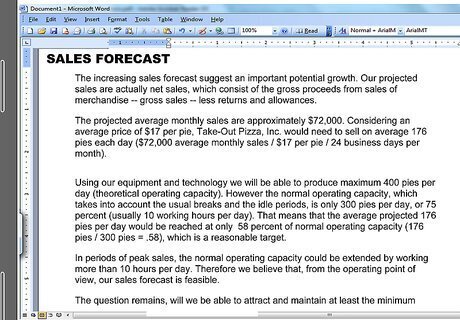
Forecast profits for the first year. As a startup, you have no financial information you can provide. Accordingly, you need to estimate your sales based on your research, industry data, and marketing strategies. You should provide “best case” and “worst case” scenarios. Use spreadsheets so that your forecasts look professional. You’ll need to make some assumptions in order to come up with a forecast of sales. You should explain these assumptions in your business plan. For example, you can write, “We assume continued interest in day spas in the Chicago area.” Another assumption is the overall health of the economy. “Although the Chicagoland economy has grown more slowly than other regions of the country, we assume that the Chicago economy will grow on par with other large metropolitan areas in the coming decade.” You can also include a four-year projection, though this is optional.
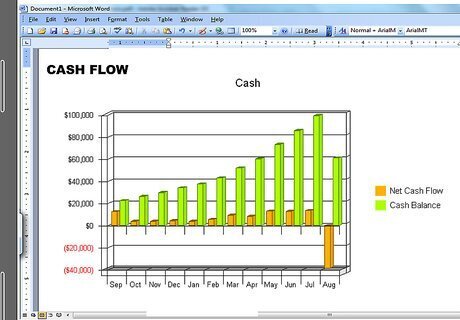
Identify expected cash flow. You need cash on hand to make payments and cover anything unexpected. You will need positive cash flow, otherwise your business might go under. As part of your cash flow analysis, you need to project the cash coming in each year and how much cash is spent on expenditures, such as sales tax, bill payments, and purchasing assets. Also talk about how you will build up your cash reserves. For example: “In addition to normal cash flow, we will focus on obtaining sufficient cash reserves for emergencies. These reserves include a line of credit with a bank, which we can use when business is slow. We will also invest excess cash in certificates of deposits at our bank.”
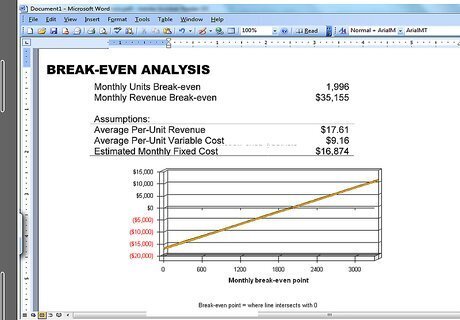
Provide a break-even analysis. Your “break even” point is the moment when your revenue equals all of your business costs. There are many business costs you need to account for: Fixed costs: these don’t vary depending on your sales volume. For example, your rent, employee salaries, and insurance are fixed costs. Variable costs: these fluctuate depending on your sales and include shipping, inventory, and manufacturing costs.
Finishing Your Business Plan
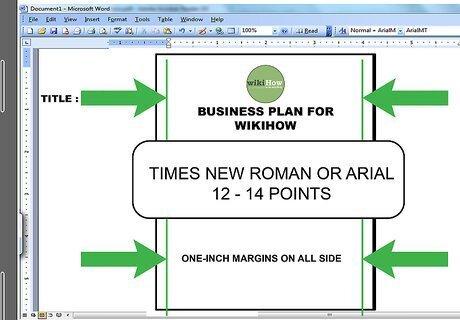
Format your document. Make the business plan look as professional as possible. Open a word processing document and set the font to Times New Roman or Garamond. Add a cover page to your document. You can title it “[Company Name]’s Business Plan” or “Business Plan for [Your Name].” If you have a logo, include that too.

Draft your executive summary. In the first section, you should summarize your business as briefly as possible. For example, you should mention what products or services you offer and where you are located. You should also briefly explain why you think you will succeed. You might want to write this summary last, but it goes first. For example, you can write, “You All Day is a start-up dedicated to providing men and women in Chicago a high-quality day spa experience at an affordable price. We specialize in pedicures, manicures, massage, and herbal aromatherapy. The Near North Side of Chicago has grown substantially over the past 20 years, with young, educated millennials settling in to start families. This area is currently under served, and we hope You All Day can meet the demand of the local market.”
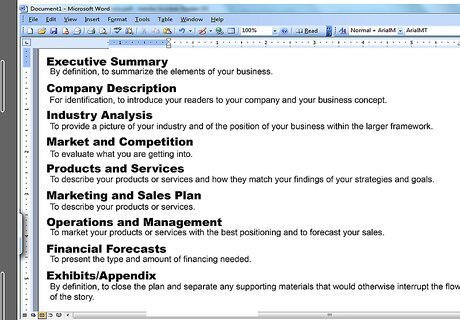
Assemble the pieces. You might write bits and pieces of your business plan over several months. However, you need to put it all together into one document. Arrange the business plan sections in the following order: Executive Summary Company Description Industry Analysis Market and Competition Products and Services Marketing and Sales Plan Operations and Management Financial Forecasts Exhibits/Appendix
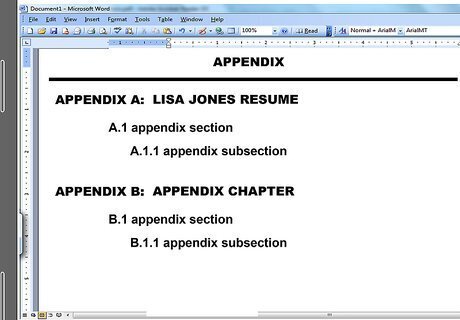
Add attachments in the appendix. This material should go in the back of the business plan. Make sure to clearly label each attachment. For example, if you include a resume then identify it: “A: Lisa Jones Resume” or something similar. Make sure your label is the same as what is mentioned in the body of the business plan.
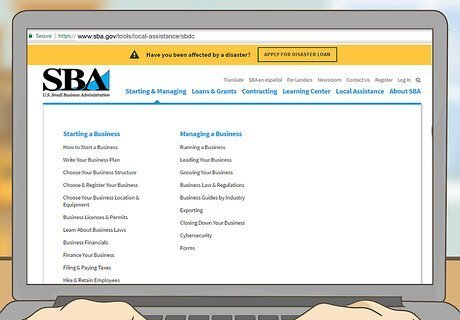
Review your business plan. Once you’ve finished a draft put it aside for a few days. When you take it back out, review with a critical eye. Does the business plan make sense? Is it too repetitive? Is it hard to read? Review for typos and other errors. An accountant should check your numbers to make sure they are accurate. Analyze the overall presentation. Is the information crammed in so that the document is tiring to read? If so, spread out the information so that there is a lot of white space on each page. You can also show the plan to a business adviser. If you live in the U.S., you can show it to someone at your nearest Small Business Development Center, which provides help drafting business plans. You can find your nearest SBDC by visiting this website: https://www.sba.gov/tools/local-assistance/sbdc.

Print and bind the plan. Use quality paper—the brightest white you can find. If you have pie charts or other graphics, you’ll want to print in color. Bind the plan using a three-ring binder or more sophisticated methods of binding available at Staples or other printers. You might want to include tabbed partitions between each section of your business plan. This will make it easier for someone to flip through it and find what they are looking for.


















Comments
0 comment